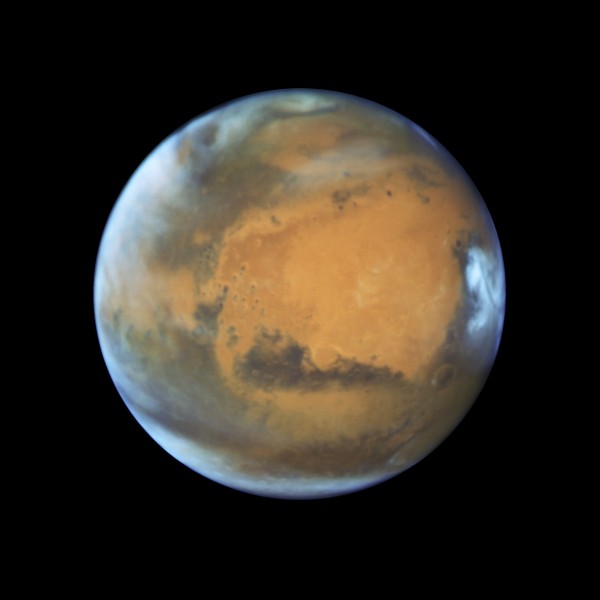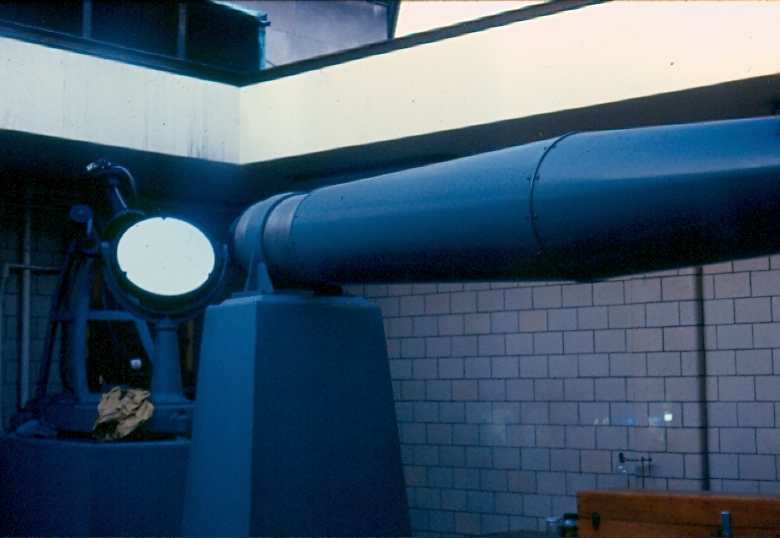 New photograph of the Planet Mars, taken by NASA's Hubble Space Telescope, on 2016 May 12,
just before the closest approach to Earth on May 30.
[Image Sources: NASA, ESA, Hubble Heritage Team, J. Bell, M. Wolff]
New photograph of the Planet Mars, taken by NASA's Hubble Space Telescope, on 2016 May 12,
just before the closest approach to Earth on May 30.
[Image Sources: NASA, ESA, Hubble Heritage Team, J. Bell, M. Wolff]
By Glenn A. Walsh
Reporting for SpaceWatchtower
In what should be the best view in a
decade during the last weeks of May and the first weeks of June, the
Planet Mars will be bright and quite noticeable in the evening and
early morning sky! This is the brightest Mars has appeared since the
Martian opposition of 2005 November 7.
On Saturday night (May 21) after
sunset, Mars will be extremely easy to find as it is passed by the
smallest Full Moon of 2016 (and, a “Blue Moon” by one
definition!). During the mid-evening after sunset, Mars can be found
just to the right of the Full Moon as both planetary bodies are
rising in the southeastern sky. While Mars is known as the red
planet, a bright reddish-orange star, Antares (in the Constellation
Scorpius the Scorpion), can also be seen below Mars. And, to the left
of Antares, below the Moon, is another planet: the beautiful
ringed-planet, Saturn.
In the early morning sky before
sunrise, on Sunday morning (May 22), the configurations will be
different. Now, Mars can be found below the Full Moon as both
planetary objects are getting ready to set in the southwestern sky.
Antares is to the left of Mars, while Saturn is above Antares and to
the left of the Full Moon.
After May 22, over the next few weeks Mars will continue to be found rising in the southeast after sunset and setting in the southwest before sunrise.
As with all planets, the best time to
view Mars and Saturn with a telescope is when they are highest in the
sky—right now, that would be between 1:00 and 2:00 in the morning,
local daylight saving time.
Known as the red planet, particularly
during the weeks around the time of opposition, Mars does appear in
the sky with a bright, easily seen orange-yellow tint. With a
modest-size telescope, or even binoculars, the orange color is even
more pronounced.
In a telescope, and with good seeing
conditions, one might be able to see a few vague lines on the planet,
and perhaps even a tiny white polar cap. Although the bright, white
ice at the north polar region of Mars is currently shrinking, this
polar region is now tilted 12 degrees toward the Earth
Due to Mars further distance from the
Sun than the Earth, Mars closely approaches the Earth once every two
years. The fourth planet from the Sun, at a distance from the Sun of 141.6 million miles / 227.88 kilometers, it takes Mars 686.971 days (1.88 Earth years) to make one revolution around the Sun. The next close approach of Mars, to Earth, will be in July of
2018.
During some of these close approaches,
such as in 2016 and also in 2018, Mars comes closer than usual. Mars will be at its
closest to the Earth on May 30 at 6:00 p.m. Eastern Daylight Saving
Time (EDT) / 22:00 Coordinated Universal Time (UTC), at a distance of
46.78 million miles / 75.28 million kilometers.
This distance can also be expressed as
0.50 Astronomical Units (one Astronomical Unit, abbreviated a.u., is
the average distance between the Earth and the Sun) or as 4.2
light-minutes (similar to a light-year, a light-minute is the
distance it takes light to travel in one-minute's time). At this
distance, the disk of Mars will have a relatively large appearance,
measuring 18.4 to 18.6 arc-seconds in diameter.
At the time of closest approach, Mars,
astronomically, will have an apparent visual magnitude of -2.1. This
is just-about the brightest Mars can appear in Earth's sky, although
Mars will appear a little brighter during the Summer of 2018. And, this is almost the
same brightness as the bright Planet Jupiter (which now is just a bit brighter at an
apparent visual magnitude of -2.2), which can now be seen fairly high
in the southwestern sky, during the evening hours.
Although the closest approach is not
until May 30, Mars reaches the point in its orbit called “opposition”
on Sunday Morning (2016 May 22) at 7:00 a.m. EDT / 11:00 UTC.
Opposition, the point in the orbit of an outer planet when the Earth
is directly between that particular planet and the Sun, cannot occur
for Mercury or Venus, the two planets closer to the Sun than the
Earth. At the point of opposition, the planet is brightly visible in
the Earth's sky, from approximately local sunset to local sunrise.
At this time, Saturn is also near its
brightest, as Saturn will reach its own opposition on June 3 at 3:00
a.m. EDT / 7:00 UTC, when it will be at an apparent visual magnitude
of 0.0. The Star Antares shines at an apparent visual magnitude of
+0.96. Visual magnitudes of stars do not vary, as such magnitudes
vary for planets in our Solar System.
At the moment of posting of this blog
post (Saturday Afternoon, 2016 May 21 at 5:14 p.m. EDT / 21:14 UTC)
the Moon reaches the Full Moon phase. This is the smallest visible
Full Moon of 2016, due to a lunar apogee three days earlier. The lunar apogee
for May, the point in the Moon's orbit where it is the farthest from
Earth for the month, occurred Wednesday Evening, 2016 May 18 at 6:00
p.m. EDT / 22:00 UTC, at an Earth – Moon distance of 252,235 miles
/ 405,933 kilometers.
The May Full Moon is primarily known as
the Flower Moon to Native Americans. Due to increasing fertility in
mid-Spring, along with the end of hard frosts and warmer temperatures
better attuned to the bearing of young and the raising of crops, in
Earth's Northern Hemisphere the Full Moon of May is also known as the
Mother's Moon, and the Corn-Planting Moon or just Planting Moon. And,
as the second cross-quarter day of the year on May 1 called Beltaine,
or better known as May Day, was the time when farmers in Medieval
Europe would move their cows to the better Summer pastures, the Full Moon of May was
also known as the Milk Moon.
As the Southern Hemisphere begins to
enter their colder months, their Full Moon names for the month of May include Hunter's
Moon, Beaver Moon, and Frost Moon.
And, this year, there is one more name
for this particular Full Moon. May's Full Moon can also be called a
“Blue Moon.” However, this is not the “common” Blue Moon,
which in recent years has been defined as the second Full Moon in a
calendar month (monthly Blue Moon). And, the Moon will not
actually appear with any type of blue tint.
This month's Blue Moon designation uses
an older, more traditional, definition: the third of four Full Moons
to occur in a single calendar season (seasonal Blue Moon), the
present season of Spring. Normally, each calendar season only has
three Full Moons.
Following the 2016 May 21 seasonal Blue
Moon, the next seasonal Blue Moon will occur on 2019 May 18. The next
Blue Moon by the more common definition, monthly Blue Moon, will be
on 2018 January 31.
Internet Links to Additional Information
More about Mars: Link >>>
https://en.wikipedia.org/wiki/Mars
News: Cornell University. "Ancient Tsunami Evidence on Mars Reveals Life Potential." 2016 May 19:
Link >>>
http://www.rdmag.com/news/2016/05/ancient-tsunami-evidence-mars-reveals-life-potential
More about today's Blue Moon:
Link >>>
http://earthsky.org/tonight/blue-moon-from-dusk-until-dawn
More about a Blue Moon: Link >>>
https://en.wikipedia.org/wiki/Blue_moon
More about Saturn: Link >>>
https://en.wikipedia.org/wiki/Saturn
More about Antares: Link >>>
https://en.wikipedia.org/wiki/Antares
Source:
Glenn A. Walsh Reporting for SpaceWatchtower, a project of Friends of
the Zeiss.
2016
May 21.
 2016: 75th Year of Pittsburgh's Buhl Planetarium Observatory
Link >>> http://spacewatchtower.blogspot.com/2016/01/astronomical-calendar-2016-january.html
Like This Post? - Please Share!
2016: 75th Year of Pittsburgh's Buhl Planetarium Observatory
Link >>> http://spacewatchtower.blogspot.com/2016/01/astronomical-calendar-2016-january.html
Like This Post? - Please Share!
Want to receive
SpaceWatchtower blog posts in your inbox ?
Send request to <
spacewatchtower@planetarium.cc >..
gaw
Glenn A. Walsh, Project Director,
Friends of the Zeiss <
http://buhlplanetarium.tripod.com/fotz/ >
Electronic Mail - <
gawalsh@planetarium.cc >
SpaceWatchtower Blog: <
http://spacewatchtower.blogspot.com/ >
Also see: South Hills Backyard Astronomers Blog: <
http://shbastronomers.blogspot.com/ >
Barnestormin: Writing, Essays, Pgh. News, & More: <
http://www.barnestormin.blogspot.com/ >
About the SpaceWatchtower Editor / Author: <
http://buhlplanetarium2.tripod.com/weblog/spacewatchtower/gaw/ >
SPACE & SCIENCE NEWS, ASTRONOMICAL CALENDAR:
<
http://buhlplanetarium.tripod.com/#news >
Twitter: <
https://twitter.com/spacewatchtower >
Facebook: <
http://www.facebook.com/pages/SpaceWatchtower/238017839577841?sk=wall >
Author of History Web Sites on the Internet --
* Buhl Planetarium, Pittsburgh:
<
http://www.planetarium.cc >
* Adler Planetarium, Chicago:
<
http://adlerplanetarium.tripod.com >
* Astronomer, Educator, Optician John A. Brashear:
<
http://johnbrashear.tripod.com >
* Andrew Carnegie & Carnegie Libraries:
<
http://www.andrewcarnegie.cc >
* Civil War Museum of Andrew Carnegie Free Library:
<
http://garespypost.tripod.com >
*
Duquesne Incline cable-car railway, Pittsburgh:
<
http://inclinedplane.tripod.com >
* Public Transit:
<
http://andrewcarnegie2.tripod.com/transit >



